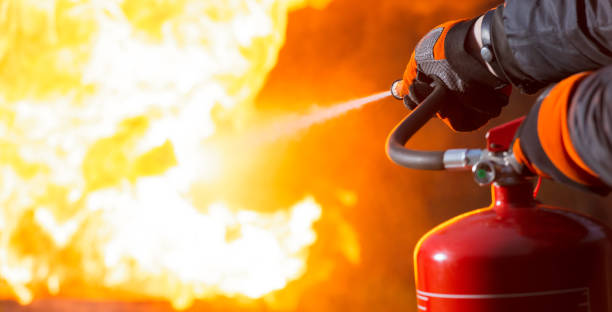When it comes to workplace safety, few threats are as unpredictable—or as devastating—as fire. Whether you operate a small business or manage a large facility, fire protection should never be an afterthought. A well-designed fire protection strategy not only safeguards your property and employees but also ensures your business remains compliant and resilient against emergencies.
1. Protect: Building a Strong First Line of Defence
Fire protection starts with the right equipment and systems in place to detect and control potential fires before they spread. These are the backbone of any fire safety plan.
Install and Maintain Fire Protection Equipment
Your workplace should have fully operational fire extinguishers, smoke alarms, sprinklers, and fire blankets strategically placed throughout the premises. However, simply installing them isn’t enough—they need regular inspections and maintenance to ensure they function properly when needed.
Routine fire extinguisher testing and Test and Tag of electrical equipment are vital to keeping your systems reliable. Faulty or untested equipment can turn a small incident into a disaster. Regular tagging also ensures compliance with Australian safety standards and helps identify any electrical hazards before they spark trouble.
Know Your Exits
In an emergency, confusion can be your biggest enemy. Clear, visible exit signs and unobstructed pathways are non-negotiable. Investing in well-designed Fire Evacuation Plans ensures everyone knows exactly where to go and what to do during an emergency, helping to minimise panic and ensure a smooth evacuation.
2. Prevent: Stopping Fire Hazards Before They Start
The best fire protection systems can only do so much if prevention isn’t part of your everyday routine. Fire prevention is all about creating a culture of awareness and responsibility in your workplace.
Regular Inspections and Maintenance
Every piece of equipment—from electrical cables to kitchen appliances—should be regularly inspected for damage or wear. Implementing a Test and Tag schedule can help identify issues before they escalate. Regular checks of electrical cords, plugs, and devices can significantly reduce the risk of electrical fires, one of the leading causes of workplace incidents.
Safe Storage and Housekeeping
Clutter, flammable materials, and improper storage are hidden fire hazards. Keep combustible items away from heat sources, maintain clear access to fire exits, and ensure waste is disposed of regularly. A tidy workplace isn’t just good for productivity—it’s essential for fire safety.
Empower Employees Through Fire Safety Training
One of the most effective fire prevention tools isn’t a piece of equipment—it’s an informed team. Regular fire safety training gives employees the knowledge and confidence to act quickly in an emergency. Training sessions should include how to use extinguishers, understanding evacuation procedures, and recognising potential fire hazards in daily operations.
Well-trained staff can make all the difference between a controlled situation and a catastrophe.
3. Prepare: Plan for the Unexpected
Preparation ensures that even in the face of an emergency, your business can respond swiftly, safely, and efficiently.
Create a Fire Evacuation Plan
Every workplace needs a comprehensive Fire Evacuation Plan that outlines escape routes, assembly points, and emergency contact details. This plan should be displayed prominently throughout the premises and reviewed regularly to reflect any layout or staffing changes.
Conduct routine evacuation drills to test your plan’s effectiveness and identify areas for improvement. The more your team practises, the more confident and calm they’ll be in a real emergency.
Install Reliable Fire Detection Systems
Modern fire detection systems are faster, smarter, and more reliable than ever. Smoke detectors and alarms should be tested periodically to ensure early detection. This quick alert can save lives and limit property damage, especially in large commercial buildings where fire can spread rapidly.
Coordinate with Local Authorities
It’s wise to collaborate with local fire services to ensure your business meets all fire safety regulations. They can offer guidance on system maintenance, evacuation procedures, and safety audits.
4. The Business Benefits of Fire Protection
Beyond compliance and safety, fire protection adds significant value to your business. Insurance premiums can be lower for workplaces with strong fire safety protocols, and a well-prepared organisation inspires confidence among clients, employees, and stakeholders.
Moreover, in industries where downtime equals loss, a proactive approach to fire protection minimises operational disruptions. Prevention and preparedness are always less costly than recovery and repair.
5. Building a Fire-Safe Culture
True fire protection goes beyond installing systems or running drills—it’s about building a safety-first culture. Encourage open communication about safety concerns, reward proactive behaviour, and make fire awareness part of your company values.
Regular refreshers on fire safety training, visual reminders like posters, and quick toolbox talks help keep safety front of mind for everyone in the workplace.
When fire protection becomes part of your everyday mindset, your entire organisation becomes more resilient.
Protect, Prevent, Prepare—with Australia Fire Protection
Fire emergencies can happen anytime, but with the right preparation, you can protect your people, property, and peace of mind.
At Australia Fire Protection, we provide complete fire safety solutions—from Fire Protection systems and Fire Evacuation Plans to Fire Safety Training and Test and Tag services. Our expert team helps you stay compliant, confident, and ready for anything.
🔥 Protect what matters most—contact us today to schedule a comprehensive fire safety assessment and make your workplace a safer place for everyone.

